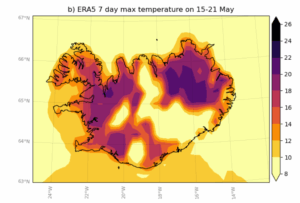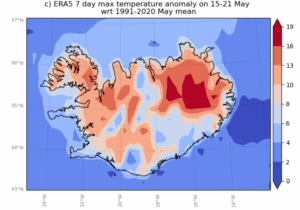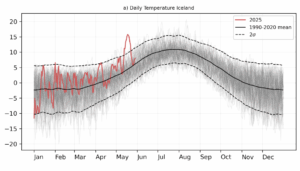Record-breaking Heat In Iceland And Greenland. On May 15, Egilsstaðir Airport logged 26.6°C, setting a new record for Iceland’s highest May temperature. Many parts of the country saw temperatures more than 10°C above average (Icelandic Met Office, 2025). On May 19, the Ittoqqortoormiit station in Greenland reached 14.3°C — over 13°C warmer than the average May daily high of 0.8°C (DMI, 2025).
Unusual Weather Pattern
This heat came from a steady flow of warm southern air. A high-pressure system near the Faroe Islands and a low-pressure system south of Cape Farewell trapped the warm air for about nine days. While similar weather setups have occurred before, this heatwave stood out because it hit so early and lasted so long.
Impacts on Ecosystems and Communities
So far, few direct impacts have been reported. However, many studies show that unusual warmth early in the year can stress cold-climate ecosystems. These delicate systems can quickly lose balance, affecting local species and the communities that rely on them.
Communities in these regions also feel the heat’s effects. Iceland and Greenland differ in services and infrastructure. In rural Greenland, coping with heat is much harder. For example, extreme heat and rain in 2022 caused permafrost to melt, releasing iron and other metals into Arctic lakes and raising concerns about water quality. Many rural homes still rely on bag toilets dumped outdoors, which can pose bigger health risks when warmer weather speeds up bacterial growth.
Record-breaking Heat In Iceland And Greenland
Researchers from Iceland, the Netherlands, Sweden, Denmark, the US, and the UK teamed up to examine how human-driven climate change shaped this heatwave. They focused on the seven hottest days in May over Iceland, since the heat lasted longer there and affected more people. They also analysed the single hottest May day at Ittoqqortoormiit, Egilsstaðir Airport, and Reykjavik to see how rare local peaks were.



Figure 2: TX7x anomaly with respect to May climatology over the period of 1991-2020. Data ERA5.
A heat wave in a cold-adapted environment can look very different from those in other parts of the world. In Greenland and Iceland, infrastructure is built for freezing conditions, so when extreme heat strikes, ice melt can flood roads and damage key facilities. Iceland, melting bitumen caused roads to bleed, creating hazards for drivers. In Greenland, unusual warmth breaks up sea ice, threatening communities that rely on it for hunting, fishing, and travel.
This shift affects food security, mobility, scientific research, and Indigenous knowledge. Warmer seas are also moving fish stocks north; cod and mackerel are rising while cold-water shrimp and halibut are declining, straining local economies. More seaweed and less natural fodder have forced farmers to import hay from Iceland, raising costs and linking the two economies.
Record Temperatures and Return Periods
Temperatures in Iceland this May broke records, spiking more than 13°C above the 1991–2020 average daily maximum for May. In the current climate, warmed globally by 1.3°C, the 7-day maximum and the temperatures seen in 2025 have a return period of about once every 100 years. In a cooler climate, this heat would have been extremely rare.
When scientists combined observations with climate model data, they found that models still underestimate the rise in heat but not as much as elsewhere. The combined analysis shows that climate change made the extreme heat about 3°C hotter and about 40 times more likely. The estimate for increased likelihood has uncertainty and is smaller than in other heat studies for similar latitudes. Because models tend to understate warming, the real influence is probably greater.
More Heat Likely as Warming Grows
If the planet warms to 2.6°C, these extreme events will likely double in frequency and become another 2°C hotter. The new record of 26.6°C at Egilsstaðir, East Iceland, is now expected about once every 110 years in today’s climate. Looking at both Egilsstaðir and Reykjavík shows slightly lower trends in single-day May maximums compared to the national 7-day heat average. The Ittoqqortoormiit station in East Greenland, however, shows a similar trend to Iceland’s 7-day data. Extrapolating back to pre-industrial times suggests May temperatures there have risen by about 3.9°C.
Both countries mirror the wider Arctic trend of rising temperatures and shifting rain and snow patterns. These changes push adaptation higher up the agenda. Iceland is drafting new national climate plans to protect infrastructure and communities. In Greenland, heat is now seen as an emerging public health challenge that needs more urgent action.

